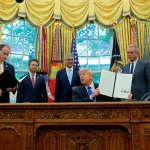Authored by Marc Joffe via The Epoch Times,
President Donald Trump has announced his intention to shut down California’s cap-and-trade program, which raises revenue for the state and reduces greenhouse gas emissions.
If successful, the Trump administration will deal a major blow to California’s ambitions to be a climate change policy leader by starving multiple state programs of funds, but success is by no means guaranteed.
Cap-and-trade is a pollution-reducing mechanism popular with some economists. Instead of banning emissions outright or explicitly setting limits on the volume of pollutants each company may generate, the state sets an overall limit on emissions and then auctions off permits that allow firms to generate a portion of the overall emissions target.
According to the Legislative Analyst’s Office (LAO), the program generates about $4.4 billion annually on average. Under existing law, certain state programs automatically get a share of these proceeds, but the governor and legislature can exercise discretion with some of the funds each fiscal year.
A sizable portion of the funds is devoted to decarbonizing the transportation sector. In Gov. Gavin Newsom’s 2025–2026 budget, $936 million is allocated to California High-Speed Rail, $374 million is earmarked for the state’s Transit and Intercity Rail Capital Program, and $187 million is allocated to Caltrans’ Low Carbon Transit Operations Program, according to the LAO.
If the Trump administration were able to terminate cap-and-trade, the consequences would be especially devastating to the High-Speed Rail program. This initiative already lacks the necessary funds to connect Merced to Bakersfield by the early 2030s. Under the administration, no new federal grants are likely, and the federal Department of Transportation may attempt to claw back Biden-era grant commitments.
This leaves cap-and-trade allocations as the sole source of reliable revenue for high-speed rail. Without it, the program would likely have to be put on hold until Democrats regain the White House or be canceled entirely.
As I have discussed in these pages previously, California’s High-Speed Rail program is a poor use of taxpayer funds and should be wound down, so an administration win on this issue could be seen as a positive.
Other transit spending facilitated by cap-and-trade is also dubious. Many local transit expansion projects are extremely costly, take too long to build, and yield only marginal ridership growth once completed. Transit operations, relying as they do on costly and inflexible unionized employees, are also inefficient and could be streamlined in the event of a reduction in state funding.
Although cap-and-trade is not an inherently bad idea, extracting funds from the productive segment of the economy to spend on wasteful projects makes the California program a net negative. So, a federal challenge to California cap-and-trade should be welcome.
But that does not mean the challenge will be successful. In Trump’s April 8 executive order, he instructs Attorney General Pam Bondi to “identify all State and local laws, regulations, causes of action, policies, and practices (collectively, State laws) burdening the identification, development, siting, production, or use of domestic energy resources that are or may be unconstitutional, preempted by Federal law, or otherwise unenforceable.”
At the beginning of the order, Trump calls out the California program, saying that it “punishes carbon use by adopting impossible caps on the amount of carbon businesses may use, all but forcing businesses to pay large sums to ‘trade’ carbon credits to meet California’s radical requirements.”
If Bondi chooses to shut down cap-and-trade, she can expect an aggressive defense from the state government, which previously set aside funds to litigate against the Trump administration.
When Trump was last in office, his Department of Justice (DOJ) tried and failed to kill the cap-and-trade program. In 2019, the DOJ sued on the basis that California usurped federal authority by implementing its program in conjunction with the Canadian province of Quebec. But a District Court judge ruled in favor of California.
DOJ then appealed to the Ninth Circuit Court. But before the appeal could be heard, Trump lost the 2020 election and Joe Biden assumed office. Since the Biden administration supported California’s climate policy, his DOJ dropped the lawsuit. That action left the District Court’s decision as the final word since the legal doctrine of res judicata (claim preclusion) forbids the matter from being relitigated.
This means that Bondi will have to find a new rationale for invalidating the cap-and-trade program and convince judges that its argument is sound. Since she would be starting early, the new administration may have time to escalate the matter to the Supreme Court, which should have a conservative majority at least through 2029.
We may well see litigation over California’s cap-and-trade program through the remainder of the second Trump administration. It would then become one of the many legal fronts in the war between the federal executive branch and the California state government.
Views expressed in this article are opinions of the author and do not necessarily reflect the views of The Epoch Times or zh.
Loading…











